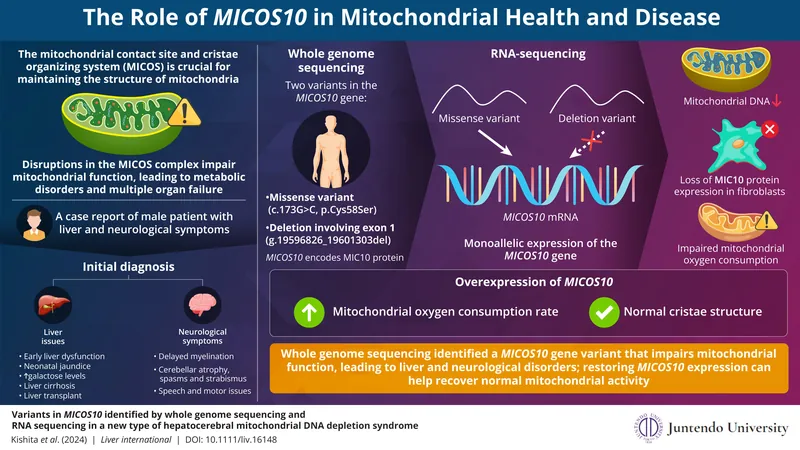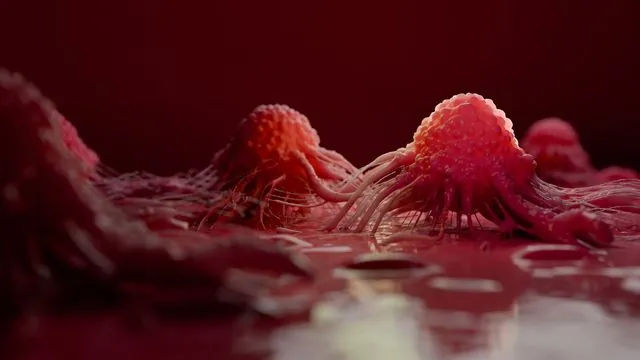
Groundbreaking Discovery: Novel Genetic Cause of Mitochondrial DNA Depletion Syndrome Unveiled!
2024-11-25
Author: Li
Introduction to Mitochondrial DNA Depletion Syndrome
Mitochondrial DNA depletion syndrome (MTDPS) is a rare but serious genetic disorder characterized by a dramatic reduction in mitochondrial DNA (mtDNA), severely impacting organ function and overall health. This condition manifests in various symptoms, most notably muscle weakness, profound fatigue, and significant neurological issues, particularly when the liver and brain are involved, as observed in hepatocerebral MTDPS cases.
The Role of Mitochondrial Genes
Mitochondrial diseases are among the most prevalent metabolic disorders, with over 400 associated genes identified to date. Many of these genes are linked to the mitochondrial contact site and cristae organizing system (MICOS) complex, indicating the intricate web of genetic factors intertwined in these disorders.
Pioneering Research Study
In a pioneering study published in Liver International on November 7, 2024, a team of researchers led by Professor Yasushi Okazaki from Japan's Juntendo University, made noteworthy strides in unraveling the complexities of MTDPS.
The dedicated team, which includes Dr. Kei Murayama, Dr. Yoshihito Kishita, and Dr. Ayumu Sugiura, utilized cutting-edge technologies like whole genome sequencing and RNA sequencing to pinpoint a specific variant in the MICOS10 gene in a young patient suffering from MTDPS. Professor Okazaki stated, “This is the first report of MICOS10 variants in hepatocerebral MTDPS. Understanding how defects in this complex impact cristae formation and mitochondrial function could provide vital insights into the molecular mechanisms underlying this condition.”
Case Study Overview
The study centered on a young patient who was severely affected by liver dysfunction, ultimately leading to cirrhosis and developmental delays. Despite a liver transplant, the patient continued to grapple with neurological symptoms. Comprehensive laboratory tests unveiled significant anomalies in the mitochondrial respiratory chain and revealed that mtDNA levels in liver tissue taken during the transplant were shockingly low—only 23.7% of what is considered normal, which solidified the diagnosis of MTDPS.
Genetic Findings
In a detailed analysis, two critical variants in the MICOS10 gene were identified: a single nucleotide missense mutation and a deletion affecting a large portion of exon 1. Although both gene copies were present, only the one with the missense mutation was functional, as the deletion prevented the other copy from being expressed. This single actively misfiring variant critically disrupted mitochondrial function, leading to the patient's debilitating symptoms.
Functional Studies
To validate their findings, researchers conducted functional studies in fibroblast cells derived from the patient. Remarkably, restoring MICOS10 expression dramatically improved mitochondrial respiration, as evidenced by increased oxygen consumption rates, while also correcting abnormal cristae structures in the cells. This underscores the vital role that MICOS10 plays in maintaining mitochondrial architecture and function.
Implications of the Research
The revelations from this research not only elevate our comprehension of mitochondrial diseases but also open the door to new genetic testing and therapeutic strategies. With Professor Okazaki emphasizing, “Clarifying genetic variants that were previously undetectable could significantly enhance diagnostic efficiency for mitochondrial disorders,” the study highlights the potential for tailored treatment approaches.
Conclusion
These groundbreaking insights pave the path for innovative therapies aimed at restoring mitochondrial function, igniting hope for patients battling these intricate genetic disorders. As we deepen our grasp of MTDPS and champion the power of advanced genetic diagnostics, a brighter future seems within reach, offering renewed optimism to families impacted by mitochondrial diseases. Stay tuned as we follow the developments from this exciting research front and explore the implications for the future of mitochondrial disease treatment!


 Brasil (PT)
Brasil (PT)
 Canada (EN)
Canada (EN)
 Chile (ES)
Chile (ES)
 España (ES)
España (ES)
 France (FR)
France (FR)
 Hong Kong (EN)
Hong Kong (EN)
 Italia (IT)
Italia (IT)
 日本 (JA)
日本 (JA)
 Magyarország (HU)
Magyarország (HU)
 Norge (NO)
Norge (NO)
 Polska (PL)
Polska (PL)
 Schweiz (DE)
Schweiz (DE)
 Singapore (EN)
Singapore (EN)
 Sverige (SV)
Sverige (SV)
 Suomi (FI)
Suomi (FI)
 Türkiye (TR)
Türkiye (TR)